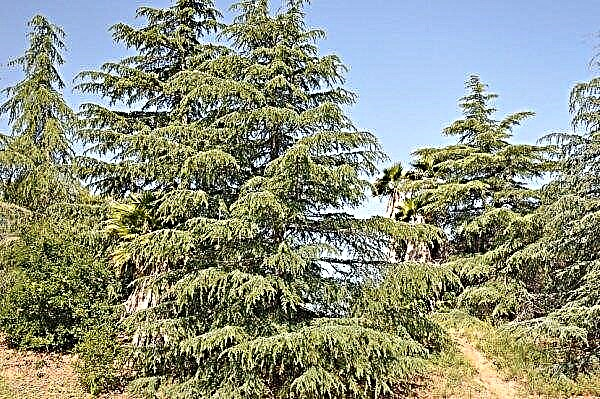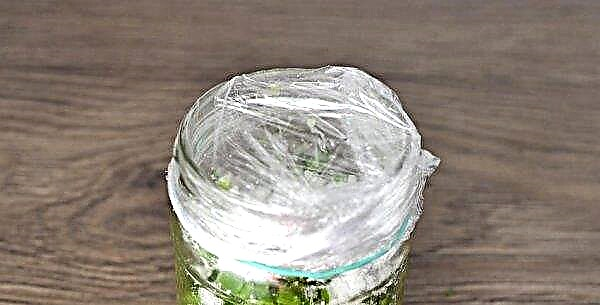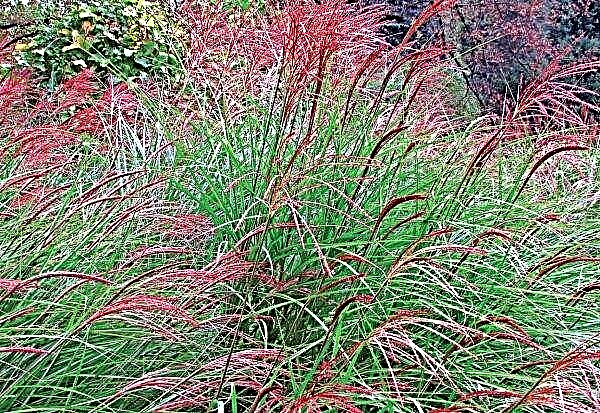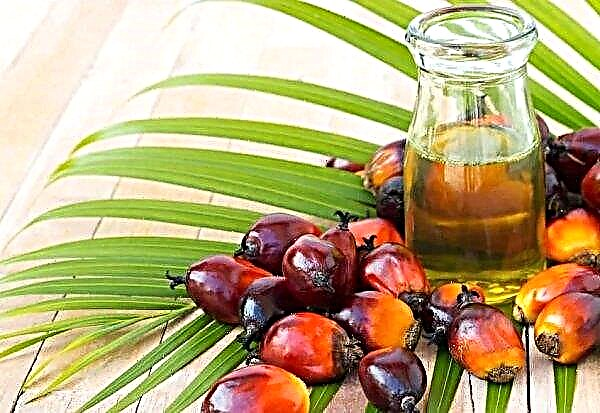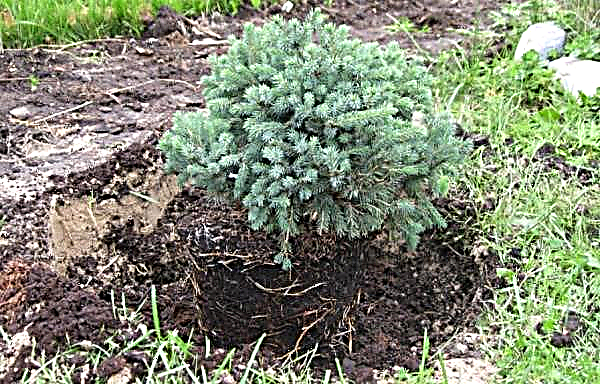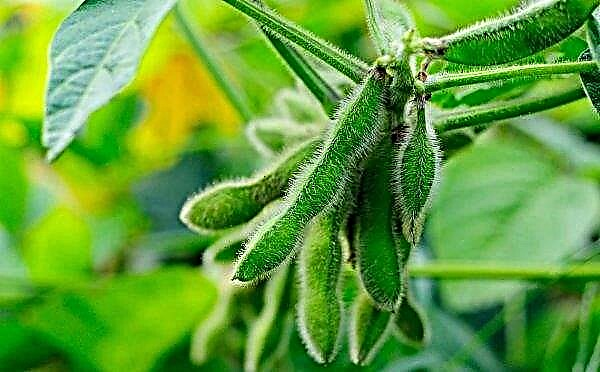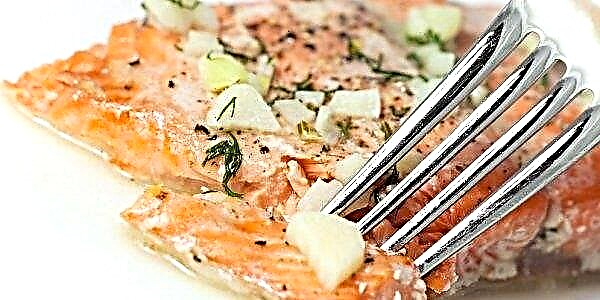Juniper Pfitzeriana is a perennial bush with a unique appearance that attracted a considerable number of gardeners. In addition to appearance, the plant boasts useful substances that it releases, purifying the air from bacteria. All this markedly distinguishes the specified juniper from other bushes - about its features later in the article.Description of the popular varieties of juniper Pfitzerian.
Botanical Description
This is a coniferous bush with curved lush branches. The needles have a green color all year round, and its needles are soft and needle-shaped. The size of the shrub directly depends on its variety, but on average, the height reaches 1.5 m and the diameter is 3 m.
Juniper is not picky about planting conditions and adapts to urban conditions without problems. It is also widely used in landscape design, and each of its varieties, despite its similarity, is worthy of special attention.
Did you know? Wild Juniper is a kind of mark for a geologist. The thing is that bushes are often formed close to coal seams.
The best varieties of Pfitzeriana
Juniper Pfitzeriana combines a huge variety of varieties, the very first of which is Wilhelm Pfitzer, or juniper medium. The bush got its name in honor of the breeder who bred him.

It was he who set a certain standard for other varieties - a lush crown with a predominance of green and sprawling branches. Most varieties are similar to each other and differ only in size. However, there are several varieties of Pfitzerian that have their own distinctive features.
Mint Julep
Due to its spreading branches, the plant is very large, up to 3 m in diameter. It has a bright green color of needles. Gardeners prefer to make living walls out of this variety or plant them individually in parks. Widely distributed in the USA.

Compact (Compacta)
A relatively small bush. It reaches a height of 80 cm, and no more than 2 m in diameter. The crown is compact, gray-green in color. Compact branches, unlike other varieties, are spread on the ground. Despite its small size, this plant is practically not suitable for small garden compositions, but it looks great in parks.

Aurea
The main feature of the variety is a widely growing crown. If the average diameter of the juniper is 3 m, then this bush can reach 5 m. The crown is green with an admixture of yellow tones. The variety is notable for its resistance to cold and unpretentious care in general. Given the size, not suitable for small flower beds.

Glauca
This variety is noticeably different from other junipers. It has a peculiar shape resembling an irregular ball. It also highlights the plant and its color, which instead of the usual green tones has a bluish-blue color. Glauka usually lands on rocky terraces and hills.

Mordigan Gold
Bush with a golden green color. It is small: its height is within 1 m, its width reaches 1.5 m. It grows on any soil. Compared with other varieties of juniper, Mordigan Gold grows significantly slower - it adds 10 cm per year, with an average of 30 cm. It is universal, because of its color and shape it looks great both in group compositions and alone.

Old Gold
One of the most popular varieties. This is due to its small size: its height is 0.5 m, its width is 1 m. Its neat and even shape is also noteworthy. The adult plant has a golden green color, but the young shoot is completely yellow. Old Gold can be grown not only in open ground, but also in containers. The bush looks great on the lawns.

Gold Coast
Bush for single compositions. It grows slowly and reaches a maximum growth of 1 m, reaches within 10 years. The crown is open and reaches 3 m in diameter, has a green color with yellow tones. It is important to consider that the more sun there is at the landing site, the yellow the crown will be.

Blue and Gold
A distinctive feature of this plant in colors, which combines gold and blue. In addition, each shoot has its own shade. Due to this feature, the shrub will look good in composition with other evergreens.
Landing and further care
The best place to land is well-lit areas. Places with slight shading are also suitable. Juniper is absolutely not picky about the soil, but on fertile land it grows faster. The distance between the seedlings depends on the selected variety, but usually is not less than 0.5 m. Also, at the bottom of the pit, it is necessary to make a drainage layer of sand or brick chips with a thickness of 20 cm.

The depth of the pit should be such that the root neck is barely deepened. The shrub should be watered abundantly in the first week after planting and periodically loosen the soil. Then watering should be carried out only in the summer, only 2-3 times per season, but very plentifully. The norm of water is 20-30 liters per bush. However, more often it will be necessary to do sprinkling: once every 7-10 days.
Important! Water procedures should be practiced in the morning or in the evening: otherwise the plant risks getting burned.
Fertilize juniper Pfitzerian preferably only once a year. However, if necessary, you can do this more often, but no more than 1 time per month. The best time for this is the end of April or the beginning of May. Nitroammophosk is suitable as a fertilizer. 40-50 g per 1 m² will be enough.

Decorative trimming is optional. If necessary, form a hedge or other composition, it is allowed. You also need to cut dead or broken branches in spring and autumn.
The shrub has excellent resistance to cold and does not withstand only too severe frost. For young landings, mulching is required. This can be done with bark, peat, cedar shell, wood chips. The thickness of the mulch layer is 5–10 cm. If the young bush has sprawling branches, then in addition to mulching, it will also be necessary to cover the crown for the winter.
Important! With the onset of early spring, the mulch must be removed. If you do not do this or carry out such a procedure too late, then the roots will begin to rot.
Breeding methods
There are several ways to propagate juniper: by seed, division, layering and cuttings. Propagation using cuttings is the fastest, most convenient and effective way. This is due to better adaptation of seedlings to growing conditions and their faster growth.
A key criterion for successful grafting is a properly selected planting material. To create cuttings you need a juniper bush at least 8 years old. The material should be still green, not lignified. The best length of the handle is 12 cm, but more can be, most importantly, no more than 25 cm. A large length simply will not allow the handle to take root.

Before planting the stalk in the main place, you need to let its root system grow. The formation of roots is 70 days. Planting a plant until it is fully formed will result in the death of the seedling.
Landscape design application
Juniper is very common among gardeners and landscape designers. This bush adorns parks, terraces, flowerbeds and gardens. It looks good both in solitary composition and together with other plants, especially with evergreens. Also hedges are made from it.
Each of its many varieties has its own application in the decoration of territories. However There are some of the most popular varieties: Compact, Aurea, Gold Coast and Glauka. The choice of these varieties is due to their appearance and the least demands on care and a seat.
Diseases and Pests
Three diseases pose the greatest threat to juniper:
- Drying out - occurs with a fungal infection. To prevent this, do not plant shrubs on heavy soils, such as clay. Thickened landings should also be avoided. The disease is treated by circumcision of the affected parts and treatment with fungicides.

- Schütte brown - a dangerous disease. The affected plant begins to turn yellow, die, and eventually crumble. The disease attacks weak plants that are planted in the shade or in too moist soil. Affected branches are cut off, and whole ones are treated with “Quadrice” or “Strobi”.

- Rust - refers to those diseases that are easier to prevent than to treat. The causative agent is a fungus. The symptom is the stem, which swells and becomes covered with red growths. Treatment consists of pruning infected branches. Means for prevention can serve as "Vectra" or "Bayleton."

In addition to illnesses, there is a risk of pest attacks. This can be a moth, aphid, mealybug or scale insect. To control pests, you can use the following drugs: Angio, Actellik, Aktara or "Caesar".
Did you know? Juniper can easily survive the person who raised it: the plant can survive up to 600 years.
Juniper Pfitzeriana is a versatile plant that combines beneficial and decorative properties. The shrub will be a great decoration for any site. He is not demanding of care and is able to grow even in difficult conditions. All these features noticeably distinguish it from other plants.




